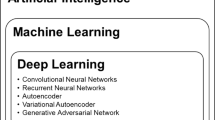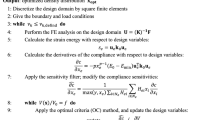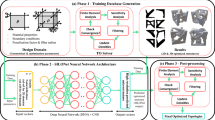Abstract
A vital necessity when employing state-of-the-art deep neural networks (DNNs) for topology optimization is to predict near-optimal structures while satisfying pre-defined optimization constraints and objective function. Existing studies, on the other hand, suffer from the structural disconnections which result in unexpected errors in the objective and constraints. In this study, a two-stage network model is proposed using convolutional encoder-decoder networks that incorporate a new way of loss functions to reduce the number of structural disconnection cases as well as to reduce pixel-wise error to enhance the predictive performance of DNNs for topology optimization without any iteration. In the first stage, a single DNN model architecture is proposed and used in two parallel networks using two different loss functions for each called the mean square error (MSE) and mean absolute error (MAE). Once the priori information is generated from the first stage, it is instantly fed into the second stage, which acts as a rectifier network over the priori predictions. Finally, the second stage is trained using the binary cross-entropy (BCE) loss to provide the final predictions. The proposed two-stage network with the proposed loss functions is implemented for both two-dimensional (2D) and three-dimensional (3D) topology optimization datasets to observe its generalization ability. The validation results showed that the proposed two-stage framework could improve network prediction ability compared to a single network while significantly reducing compliance and volume fraction errors.


















Similar content being viewed by others
Data availability
The data and material can be made available upon reasonable request.
References
Abadi M, Agarwal A, Barham P, Brevdo E, Chen Z, Citro C, Corrado GS, Davis A, Dean J, Devin M, Ghemawat S (2016) Tensorflow: Large-scale machine learning on heterogeneous distributed systems. arXiv:1603.04467
Abueidda DW, Koric S, Sobh NA (2020) Topology optimization of 2D structures with nonlinearities using deep learning. Comput Struct 237:106283. https://doi.org/10.1016/j.compstruc.2020.106283
Andreassen E, Clausen A, Schevenels M et al (2011) Efficient topology optimization in MATLAB using 88 lines of code. Struct Multidiscip Optim 43:1. https://doi.org/10.1007/s00158-010-0594-7
Badrinarayanan V, Kendall A, Cipolla R (2017) Segnet: A deep convolutional encoder-decoder architecture for image segmentation. IEEE Trans on Pattern Anal and Mach Intell 39:2481–2495. https://doi.org/10.1109/TPAMI.2016.2644615
Banga S, Gehani H, Bhilare S, Patel S, Kara L (2018) 3d topology optimization using convolutional neural networks. arXiv:1808.07440
Basha SHS, Dubey SR, Pulabaigari V, Mukherjee S (2020) Impact of fully connected layers on performance of convolutional neural networks for image classification. Neurocomputing 378:112–119. https://doi.org/10.1016/j.neucom.2019.10.008
Bendsøe MP (1989) Optimal shape design as a material distribution problem. Struct Optim 1:193. https://doi.org/10.1007/BF01650949
Bendsøe MP (1995) Optimization of structural topology, shape, and material. Springer Science & Business Media, Berlin
Bendsøe MP, Kikuchi N (1988) Generating optimal topologies in structural design using a homogenization method. Comput Methods Appl Mech Eng 71:197. https://doi.org/10.1016/0045-7825(88)90086-2
Bergstra J, Bengio Y (2012) Random search for hyper-parameter optimization. J Mach Learn Res 13:281–305
Bourdin B (2001) Filters in topology optimization. Int J Numer Methods Eng 50:2143. https://doi.org/10.1002/nme.116
Bourdin B, Chambolle A (2003) Design-dependent loads in topology optimization. ESAIM - Control Optim Calc Var 9:19. https://doi.org/10.1051/cocv:2002070
Bruns TE, Tortorelli DA (2001) Topology optimization of non-linear elastic structures and compliant mechanisms. Comput Methods Appl Mech Eng 190:3443. https://doi.org/10.1016/S0045-7825(00)00278-4
Caruana R, Lawrence S, Giles L (2001) Overfitting in neural nets: Backpropagation, conjugate gradient, and early stopping. In: Advances in Neural Information Processing Systems
Chollet François (2015) Keras: the Python deep learning library. KerasIo. https://doi.org/10.1086/316861
Creswell A, Arulkumaran K, Bharath AA (2017) On denoising autoencoders trained to minimise binary cross-entropy. arXiv:1708.08487
Doi S, Sasaki H, Igarashi H (2019) Multi-objective topology optimization of rotating machines using deep learning. IEEE Trans Magn 55. https://doi.org/10.1109/TMAG.2019.2899934
Finnoff W, Hergert F, Zimmermann HG (1993) Improving model selection by nonconvergent methods. Neural Netw 6:771. https://doi.org/10.1016/S0893-6080(05)80122-4
Goodfellow I, Bengio Y, Courville A (2016) Deep learning. MIT press, Cambridge
Goodfellow I, Pouget-Abadie J, Mirza M, Xu B, Warde-Farley D, Ozair S, Courville A, Bengio Y (2014) Generative adversarial nets. Proc Adv in Neural Inf Process Syst 27:2672–2680
Gu J, Wang Z, Kuen J et al (2018) Recent advances in convolutional neural networks. Pattern Recogn 77:354. https://doi.org/10.1016/j.patcog.2017.10.013
Hinton GE, Osindero S, Teh YW (2006) A fast learning algorithm for deep belief nets. Neural Comput 18:1527. https://doi.org/10.1162/neco.2006.18.7.1527
Hu X, Li F, Samaras D, Chen C (2019) Topology-preserving deep image segmentation. Proc Adv in Neural Inf Process Syst 32:5657–5668
Ioffe S, Szegedy C (2015) Batch normalization: accelerating deep network training by reducing internal covariate shift. In: 32nd International Conference on Machine Learning. ICML 2015:448–456
Kallioras NA, Kazakis G, Lagaros ND (2020) Accelerated topology optimization by means of deep learning. Struct Multidiscip Optim 62:1185. https://doi.org/10.1007/s00158-020-02545-z
Kallioras NA, Lagaros ND (2020) DL-Scale: Deep Learning for model upgrading in topology optimization. Proced Manuf 44:433–440. https://doi.org/10.1016/j.promfg.(2020).02.273
Kingma DP, Ba J (2014) Adam: A method for stochastic optimization. arXiv 1412:6980
Kingma DP, Welling M (2014) Auto-encoding variational bayes. In: 2nd international conference on learning representations, ICLR 2014 - conference track proceedings
Larochelle H, Erhan D, Courville A, Bergstra J, Bengio Y (2007) An empirical evaluation of deep architectures on problems with many factors of variation. Proc 24th Int Conf on Mach Learn:473–480. https://doi.org/10.1145/1273496.1273556
Lecun Y, Bengio Y, Hinton G (2015) Deep learning. Nature 521:436–444. https://doi.org/10.1038/nature14539
LeCun Y, Boser B, Denker JS et al (1989) Backpropagation applied to handwritten zip code recognition. Neural Comput 1. https://doi.org/10.1162/neco.1989.1.4.541
Lee S, Kim H, Lieu QX, Lee J (2020) CNN-based image recognition for topology optimization. Knowledge-Based Syst 198:105887. https://doi.org/10.1016/j.knosys.2020.105887
Li B, Huang C, Li X et al (2019) Non-iterative structural topology optimization using deep learning. CAD Comput Aided Des 115:172. https://doi.org/10.1016/j.cad.2019.05.038
Lin Q, Hong J, Liu Z et al (2018) Investigation into the topology optimization for conductive heat transfer based on deep learning approach. Int Commun Heat Mass Transf 97:103–109. https://doi.org/10.1016/j.icheatmasstransfer.2018.07.001
Lin Q, Liu Z, Hong J (2019) Method for directly and instantaneously predicting conductive heat transfer topologies by using supervised deep learning. Int Commun Heat Mass Transf 109:104368. https://doi.org/10.1016/j.icheatmasstransfer.2019.104368
Liu K, Tovar A (2014) An efficient 3D topology optimization code written in Matlab. Struct Multidiscip Optim 50:1175. https://doi.org/10.1007/s00158-014-1107-x
Ma F, Zeng Z (2020) High-risk prediction localization: evaluating the reliability of black box models for topology optimization. Struct Multidiscip Optim:1–17. https://doi.org/10.1007/s00158-020-02648-7
Mechrez R, Talmi I, Zelnik-Manor L (2018) The contextual loss for image transformation with non-aligned data. In: proceedings of the European Conference on Computer Vision (ECCV). pp 768–783
Meng L, Zhang W, Quan D, et al (2020) From topology optimization design to additive Manufacturing: Today’s Success and Tomorrow’s Roadmap. Arch Comput Methods Eng. https://doi.org/10.1007/s11831-019-09331-1
Mirza M, Osindero S (2014) Conditional generative adversarial nets. arXiv:1411.1784
Mlejnek HP (1992) Some aspects of the genesis of structures. Struct Optim 5:64. https://doi.org/10.1007/BF01744697
Mo S, Zhu Y, Zabaras N et al (2019) Deep convolutional encoder-decoder networks for uncertainty quantification of dynamic multiphase flow in heterogeneous media. Water Resour Res 55:703. https://doi.org/10.1029/2018WR023528
Mosinska A, Marquez-Neila P, Kozinski M, Fua P (2018) Beyond the pixel-wise loss for topology-aware delineation. In: Proceedings of the IEEE Computer Society Conference on Computer Vision and Pattern Recognition
Nair V, Hinton GE (2010) Rectified linear units improve restricted boltzmann machines. Proc 27th Int Conf on Mach Learn:807–814
Nakamura K, Suzuki Y (2020) Deep learning-based topological optimization for representing a user-specified design area. arXiv:2004.05461
Prechelt L (1998) Automatic early stopping using cross validation: quantifying the criteria. Neural Netw 11:761. https://doi.org/10.1016/S0893-6080(98)00010-0
Rawat W, Wang Z (2017) Deep convolutional neural networks for image classification: a comprehensive review. Neural Comput 29:1
Ronneberger O, Fischer P, Brox T (2015) U-net: convolutional networks for biomedical image segmentation. In: Lecture notes in computer science (including subseries lecture notes in artificial intelligence and lecture notes in bioinformatics)
Sasaki H, Igarashi H (2019) Topology optimization accelerated by deep learning. IEEE Trans on Magn 55:1–5. https://doi.org/10.1109/TMAG.(2019).2901906
Scherer D, Müller A, Behnke S (2010) Evaluation of pooling operations in convolutional architectures for object recognition. In: In international conference on artificial neural networks. Springer, Heidelberg, pp 92–101
Sigmund O (1997) On the design of compliant mechanisms using topology optimization. Mech Struct Mach 25:493. https://doi.org/10.1080/08905459708945415
Sigmund O, Maute K (2013) Topology optimization approaches. Struct Multidiscip Optim 48. https://doi.org/10.1007/s00158-013-0978-6
Simonyan K, Zisserman A (2014) Very deep convolutional networks for large-scale image recognition. arXiv:1409.1556
Sosnovik I, Oseledets I (2019) Neural networks for topology optimization. Russ J Numer Anal Math Model 34:215–223. https://doi.org/10.1515/rnam-2019-0018
Svanberg K (1987) The method of moving asymptotes—a new method for structural optimization. Int J Numer Methods Eng 24:359. https://doi.org/10.1002/nme.1620240207
Van Dijk NP, Maute K, Langelaar M, Van Keulen F (2013) Level-set methods for structural topology optimization: a review. Struct Multidiscip Optim 48:437
Wang MY, Wang X, Guo D (2003) A level set method for structural topology optimization. Comput Methods Appl Mech Eng 192:227. https://doi.org/10.1016/S0045-7825(02)00559-5
Xie YM, Steven GP (1993) A simple evolutionary procedure for structural optimization. Comput Struct 49:885. https://doi.org/10.1016/0045-7949(93)90035-C
Yu Y, Hur T, Jung J, Jang IG (2019) Deep learning for determining a near-optimal topological design without any iteration. Struct Multidiscip Optim 59:787–799. https://doi.org/10.1007/s00158-018-2101-5
Zhang H, Goodfellow I, Metaxas D, Odena A (2019a) Self-attention generative adversarial networks. Proc 36th Conf on Mach Learn:7354–7363
Zhang Y, Chen A, Peng B, Zhou X, Wang D (2019b) A deep Convolutional Neural Network for topology optimization with strong generalization ability. arXiv:1901.07761
Zhang Y, Ye W (2019) Deep learning–based inverse method for layout design. Struct Multidiscip Optim 60:527. https://doi.org/10.1007/s00158-019-02222-w
Zhao H, Gallo O, Frosio I, Kautz J (2016) Loss functions for image restoration with neural networks. IEEE Trans on Comput Imaging 3:47–57. https://doi.org/10.1109/tci.(2016).2644865
Zhou M, Rozvany GIN (1991) The COC algorithm, Part II: Topological, geometrical and generalized shape optimization. Comput Methods Appl Mech Eng 89:309. https://doi.org/10.1016/0045-7825(91)90046-9
Zhu Y, Zabaras N (2018) Bayesian deep convolutional encoder–decoder networks for surrogate modeling and uncertainty quantification. J Comput Phys 366:415. https://doi.org/10.1016/j.jcp.2018.04.018
Author information
Authors and Affiliations
Corresponding author
Ethics declarations
Conflict of interest
The authors declare that they have no conflict of interest.
Code availability
An open-source 2D topology optimization MATLAB code (Andreassen et al. 2011) and 3D topology optimization code (Liu and Tovar 2014) were used to generate data. All codes for neural networks were written in Python 3.7. For neural networks, Keras (Chollet François 2015) with Tensorflow backend (Abadi et al. 2016) was used.
Replication of results
All necessary information to obtain the topology optimization data and the neural network models which allow to reproduce the results was provided in this paper. The results described in this paper can be replicated by implementing this information. The numerical codes to reproduce the results can also be provided by the corresponding author with a reasonable request.
Additional information
Responsible Editor: Nestor V Queipo
Publisher's note
Springer Nature remains neutral with regard to jurisdictional claims in published maps and institutional affiliations.
Rights and permissions
About this article
Cite this article
Ates, G.C., Gorguluarslan, R.M. Two-stage convolutional encoder-decoder network to improve the performance and reliability of deep learning models for topology optimization. Struct Multidisc Optim 63, 1927–1950 (2021). https://doi.org/10.1007/s00158-020-02788-w
Received:
Revised:
Accepted:
Published:
Issue Date:
DOI: https://doi.org/10.1007/s00158-020-02788-w




